Kraków 2024-01-12
PKP Magistrala Warszawa Zachodnia – Kraków Główny. 1934 year.
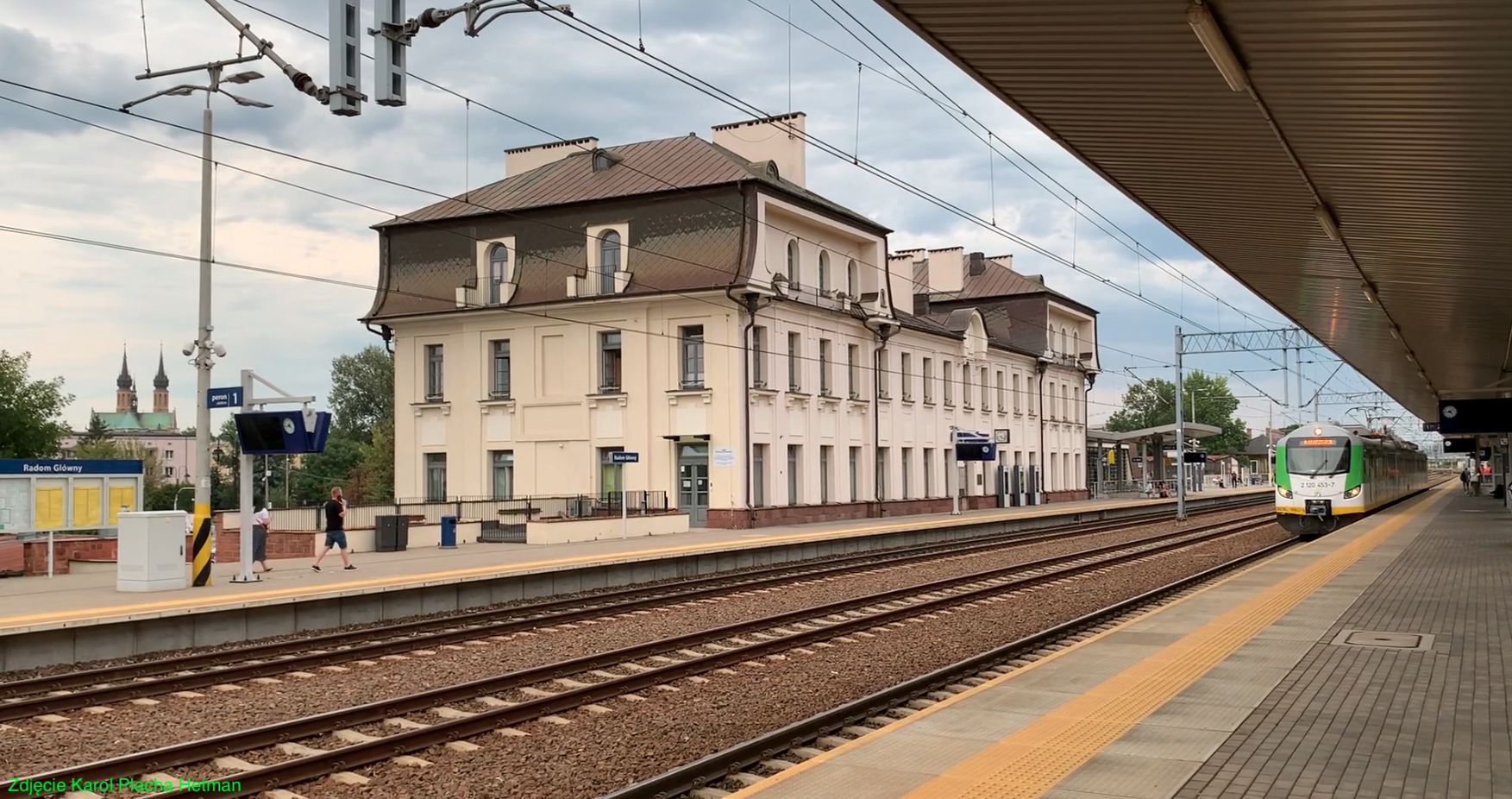
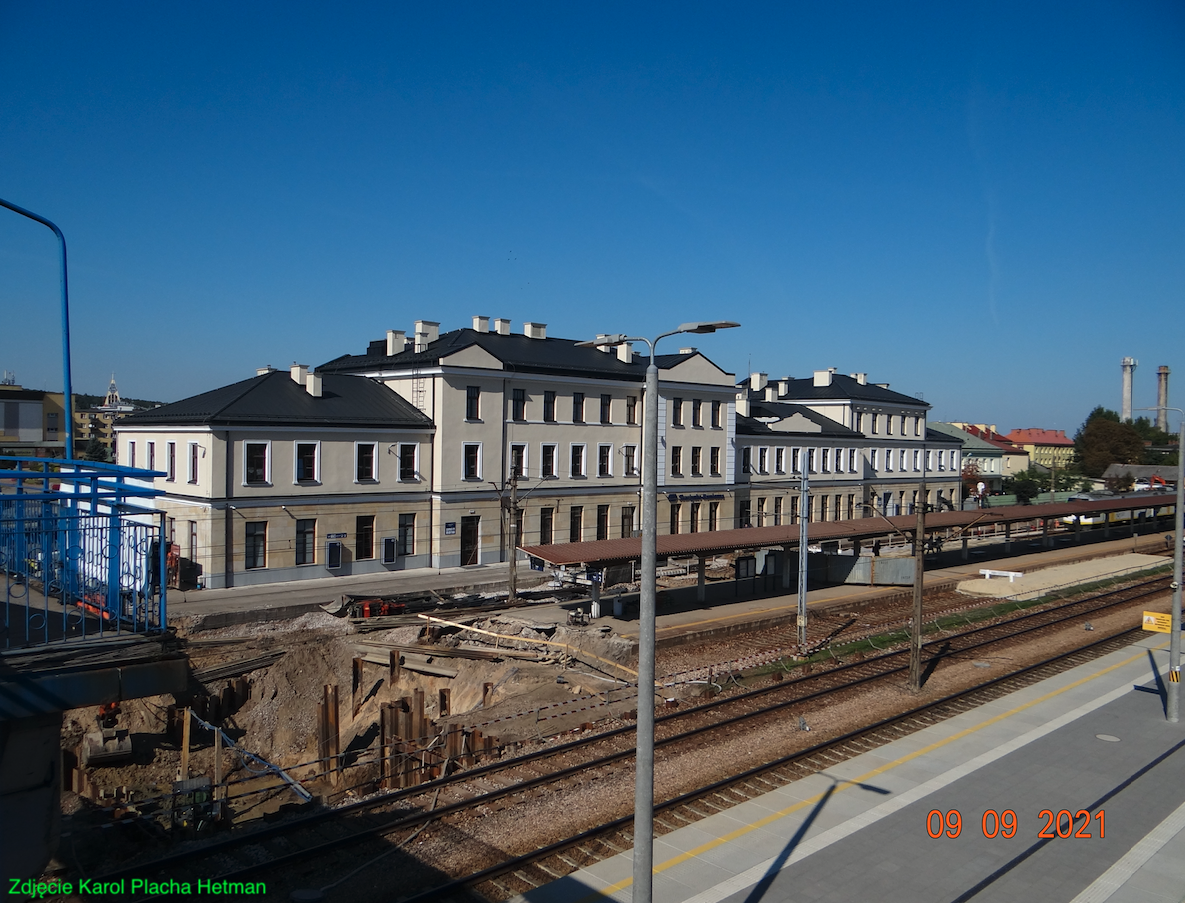
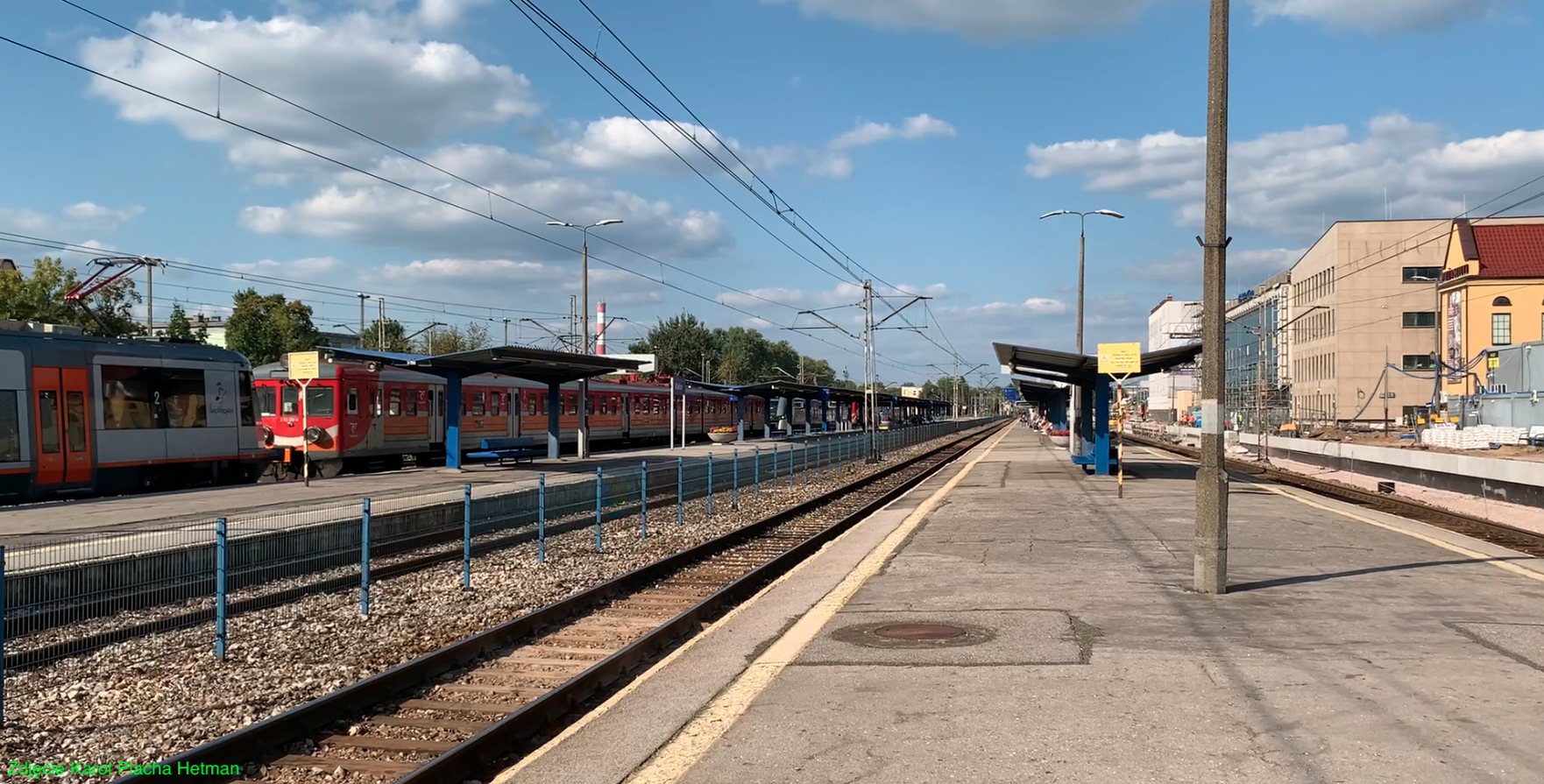
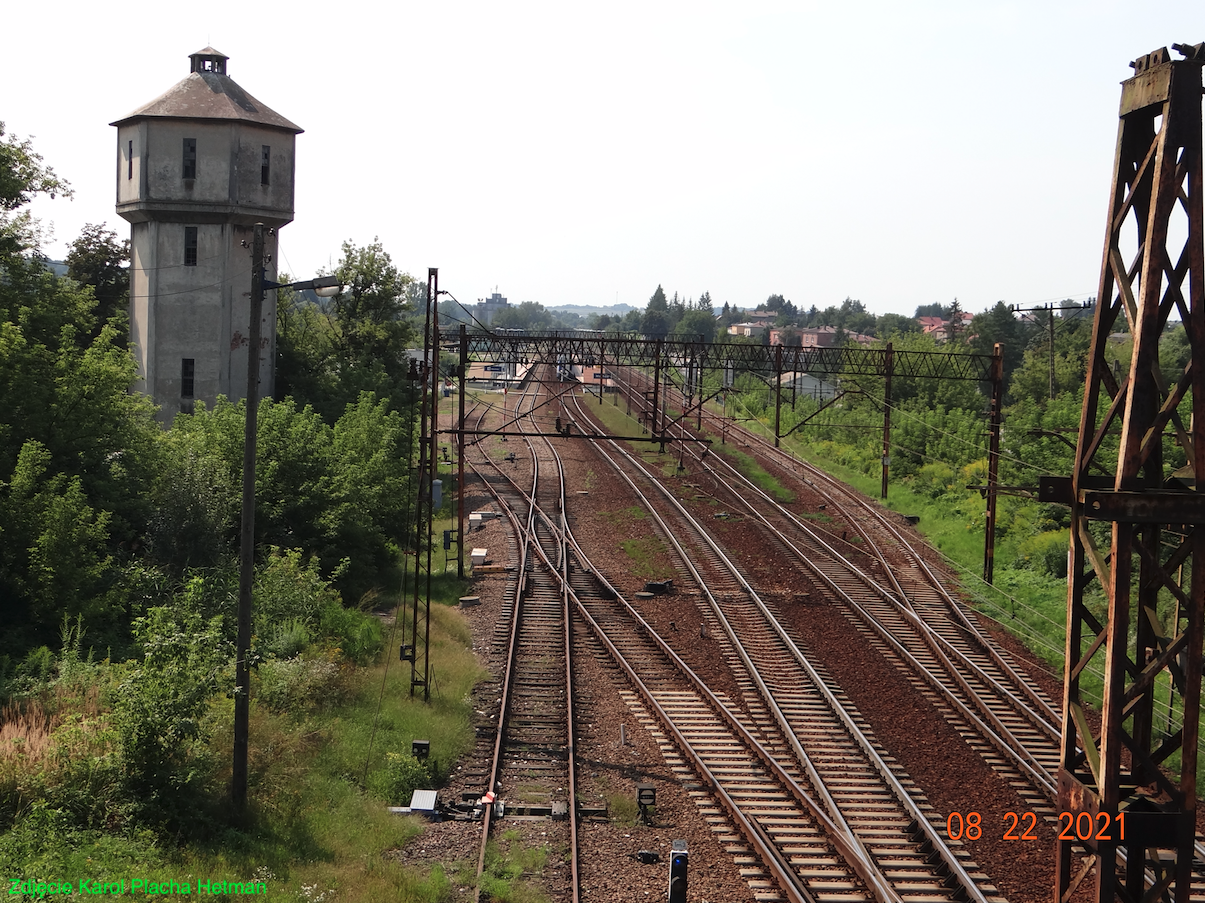
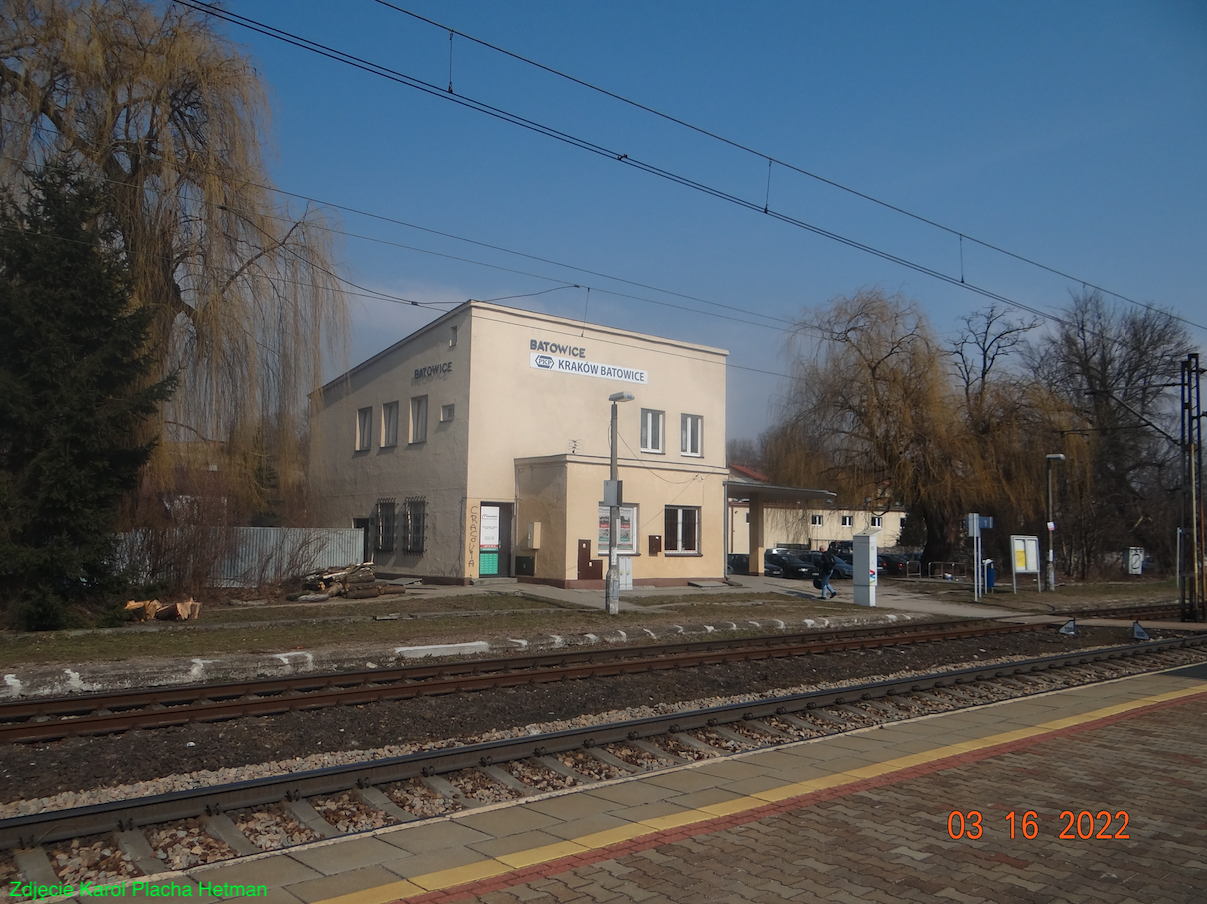
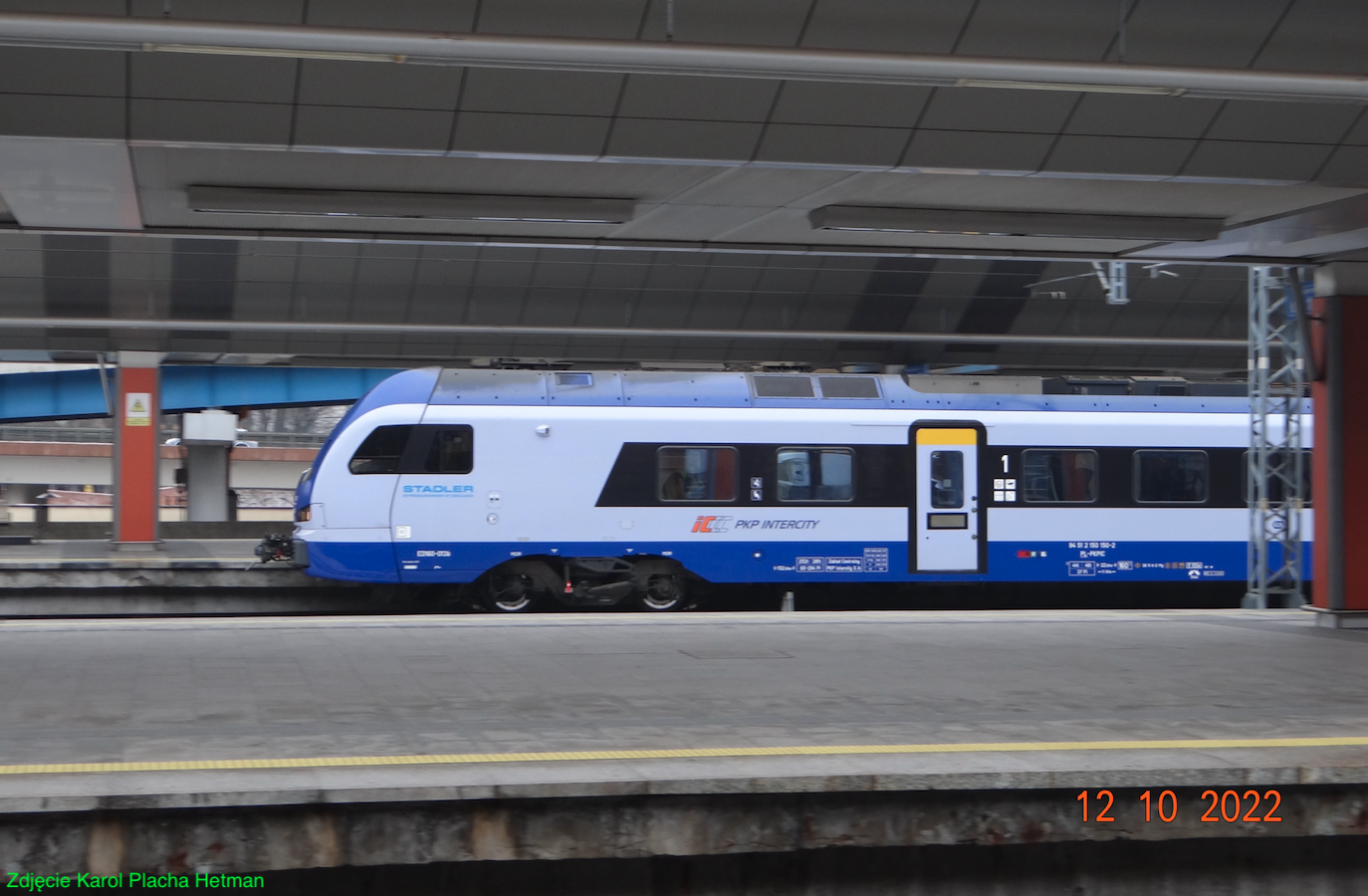
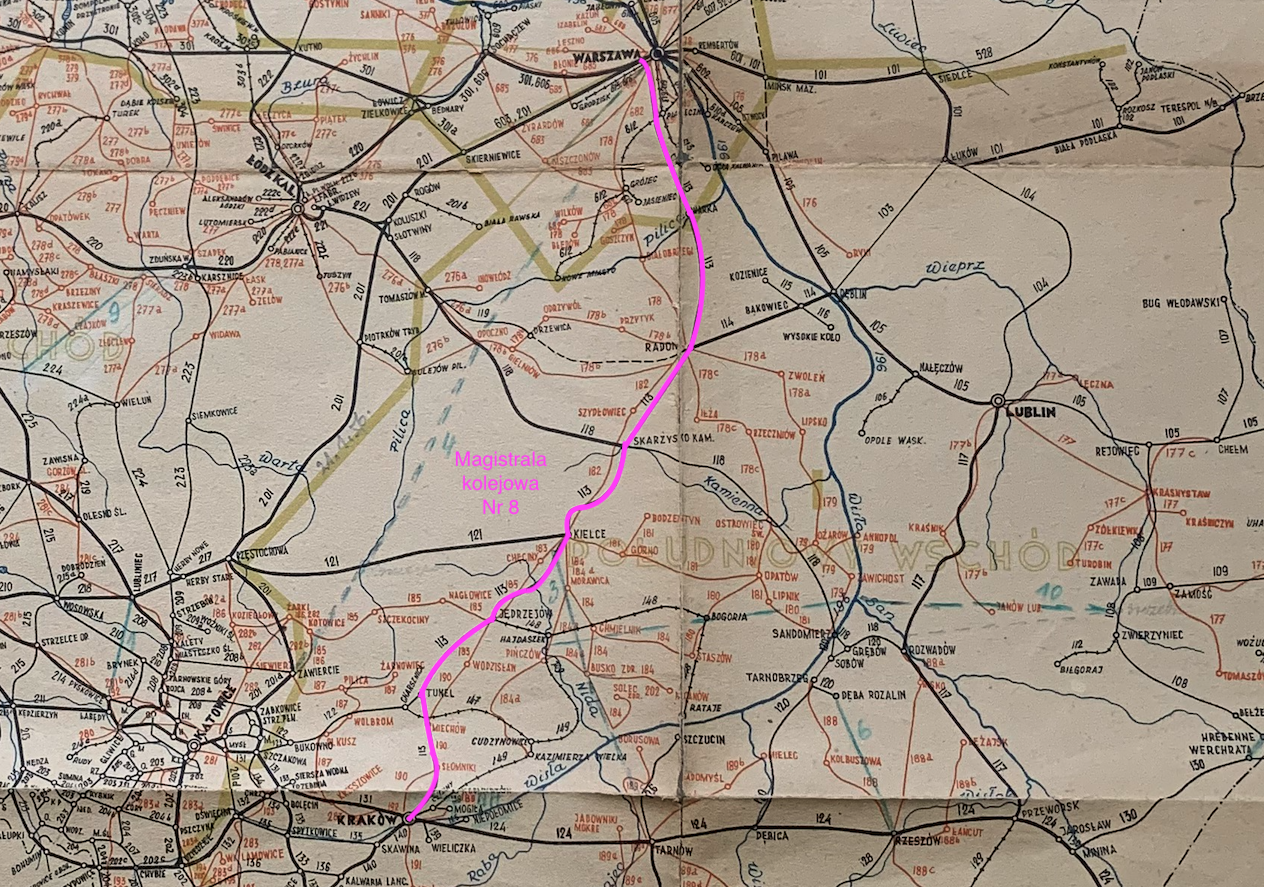
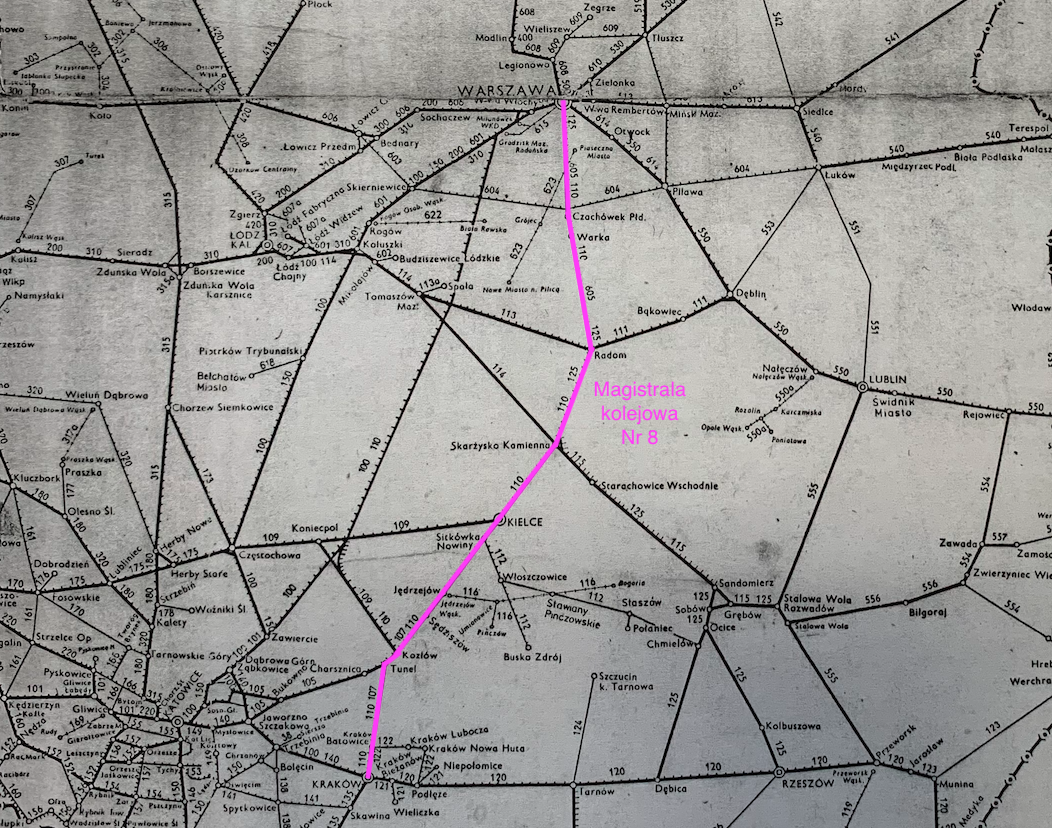
Railway line No. 8 Warszawa Zachodnia – Kraków Główny.
Railway line No. 8 Warszawa Zachodnia - Kraków Główny is one of the most important railway lines in Poland. When she was gone, the journey from Warsaw to Krakow had to be via Maczki (Granica) station or Mysłowice station.
Currently, the bus is 317.164 km long, electrified with a 3 kV DC traction network and is double-tracked. It is used in passenger and freight traffic. The maximum speed is 160 km/h for passenger trains and 120 km/h for freight trains. The most important stations on the bus; Warka, Radom, Skarżysko Kamienna, Kielce, Sędziszów, Kozłów, Miechów. There are 77 stations and passenger stops along the entire bus line.
Bus No. 8 is a first-class line of national importance. However, it is not part of the trans-European corridors, is not covered by the AGC and AGTC agreements and does not belong to the TEN network. Nevertheless, the bus is very important for the Polish economy and for passenger transport, because it connects important urban and industrial centers.
The history of the railway.
In 1934, during the Second Polish Republic, the shortest connection between Warsaw and Krakow was built. Therefore, Radom and Tunel stations became junction stations.
The Radom - Tunnel section is part of the Iwanogrodzko-Dąbrowska Railway, which was built in the period 1883–1885. However, the episodes; Warsaw - Radom and Tunel - Kraków were built in 1934. The Radom - Tunnel section was launched on January 25, 1885. The second track was opened in 1886. The line was built as a broad-gauge line. It was reforged to standard 1,435 mm gauge in 1914-1915, when the Great World War was going on, and it was done by the Germans.
Section Warsaw - Radom.
The first steam train from Warsaw arrived in Radom on July 30, 1883. It was a connection with a length of as much as 160 km, via the Vistula Railway to Dęblin (then Iwanogród) and the Iwanogrodzko-Dąbrowska Railway. The direct connection Warsaw - Radom was blocked by Muscovites; "Ministry of War". When Moscow agreed to build the route, the Great World War broke out. The proposed route through Grójec, Białobrzegi and Jedlińsk has already been marked; just like the road, and currently the S7 National Road.
Ultimately, it was only during the Second Polish Republic that the plans of the inhabitants of Radom to quickly travel by train to the capital were realized. The Radom MPs were great advocates of building this line. The decision to build a railway connection between the capital and the largest city of the then Kielce Voivodeship was made at the government level during the economic crisis and high unemployment. The construction, which cost PLN 35 million, enabled the employment of approximately 2,000 workers who had previously been unemployed. Only works related to the construction of 90 km of tracks from scratch on the Okęcie - Radom section. The existing 12 km long railway section on Okęcie was used, to the PZL Okęcie aviation plant. The work was completed at a very fast pace; during one year and eight months.
On March 19, 1933, the construction of the trail officially began when Poland celebrated the name day of Marshal Józef Piłsudski. Holy masses were celebrated both in Okęcie and Radom. The priests blessed the rails prepared for installation.
On November 25, 1934, the Warszawa Okęcie - Radom Główny section was launched. Commemorative obelisks with engraved inscriptions were placed at both ends of the trail. The opening ceremony of the line was attended by the President of Poland, the Prime Minister of Poland and local councilors. There was a holy mass combined with the consecration of the trail. In Radom, an obelisk was erected and the celebrations took place at the junction of the routes towards Dęblin and Warsaw, near the "Lublin Viaduct", on its northern side. The priests delivered solemn sermons and blessed the numerous gathered faithful. The Polish National Anthem was sung to the accompaniment of the railway orchestra.
The obelisk in Radom was interrupted by World War II. However, in the 1950s, the obelisk was removed by the communists, and their descendants now rule in Poland (2024). The inscriptions were irreversibly removed to erase all traces of free Poland in the interwar period. In Warsaw it was an impressive, oval-shaped erratic boulder weighing several tons with an inscription carved into it. The communists also successfully removed this monument. It is not even known exactly where it was placed.
In 1945, as a result of hostilities, the trail in the Warsaw area was destroyed and traffic was stopped. In 1950, after the war damage, the Warszawa Zachodnia - Warszawa Okęcie section was opened.
Tunel - Kraków section.
The Tunel - Kraków section was built at the same time as the Warsaw - Radom section; 1933-1934.
The history of the railway stop, and then the Tunel railway station, is related to the construction of a double tunnel on the Iwangrodzko-Dąbrowska Railway. It was the Muscovites' requirement that there be two tunnels on the route, which could be blown up in the event of an armed conflict and block rail transport. During the construction of the tunnels, a number of buildings were built on the southern side of the inlet and were used by the builders. Initially, iron gates were installed at the tunnel entrances, which were opened only when the train was passing. Due to the poor knowledge of the designers and builders, the tunnel was flooded by water from leaking walls. Multiple attempts to fix the fault did not help much. Repairs to the tunnel were repeated for many subsequent years. The appointed commissions ruled that passing through the leaking tunnel did not pose a threat to trains and the tunnel was constructed very carefully. Even pieces of the brick cladding falling off did not cause any concern and the defects were only ordered to be removed. Additionally, drainage was made to remove the accumulated water. A brigade of workers was organized to perform these ad hoc repairs. The brigade had a special train with tools and necessary materials at its disposal. Repair works were carried out at night, when no trains passed through the tunnel. For the safety of train passage, a telegraph station "Przysieka" was organized near the tunnels to receive messages that allowed the train to enter the tunnel. No train entered the tunnel without an appropriate message. During heavy rainfall, the tunnel was inspected before each train passage.
During the Great World War, in December 1914, Austrian and Germanic troops were defeated near Dęblin and Warsaw and began to retreat from the Muscovites. German sappers were brought into the tunnel and placed explosives. The sappers had a special train that was standing on a side track from Miechów and had a lot of explosives; pyroxylin cartridges. The last train with the German army, which was carrying about 600 soldiers, was to quickly pass through the tunnel. But after passing through the tunnel at full speed, the switch was set to a side track with a sappers' train on it. There was a collision and a huge explosion. There were many dead and wounded. But the tunnels were not badly damaged and could be repaired quickly.
The Tunel - Kraków section is 51.64 km long. The trail was built immediately as a double track. The line was launched on November 24, 1934. A few days later, a second track was opened on the Raciborowice - Kraków Batowice section. 5 new stations were built on the Kraków - Miechów route. These are the following stations from Krakow: Sudoł, Łuczyce, Słomniki, Miechów and Tunel. The latter station is a railway junction where the new line connects with the old Strzemieszyce - Kielce route. After the new railway line was launched, passenger, luggage and express traffic was obligatory for all journeys and transports. Initially, freight traffic was only for the transportation of parcels between stations. Once built on stations; ramps, warehouses and storage yards, freight traffic was launched. The axle load on the tracks of the new line was 17,000 kg.
Between May 22, 1937 and May 24, 1937, train traffic was suspended on the Tunel - Słomniki section. This was due to the tracks being washed away as a result of heavy rains. The damage was quickly repaired.
Further history of the Warsaw - Kraków railway line.
Only on October 17, 1911, the second track was opened on the Radom Główny - Skarżysko Kamienna section. According to available information, the entire trail was double-tracked at that time. We do not have full information about the condition of the main line after World War II. We can guess that, in accordance with Soviet practice, many double-track routes were deprived of a second track, and the rails and sleepers were taken to Moscow as trophies. This assumption is confirmed by the dates when the second track was launched already during the Polish People's Republic. The second track on the trail was launched in stages: In 1972, the second track was launched on the Łuczyce - Kraków Przedmieście section. In 1973, the Tunel - Goszcza and Goszcza - Łuczyce sections. In 1989, a second track was opened on the Kraków Przedmieście - Kraków Główny section.
Electrification of the main line was carried out in stages over the last 60 years; On May 28, 1960, Kraków Batowice - Kraków Główny. On December 22, 1961, Warszawa Zachodnia - Czachówek Południowy. On September 8, 1966, Sędziszów - Tunel. On April 29, 1967, Kielce - Sędziszów. On October 1, 1967, Zagnańsk - Kielce. On December 28, 1967, Radom - Zagnańsk. On April 22, 1968, Tunel - Kraków Batowice. On November 21, 1969, Czachówek Południowy - Radom.
In the 1970s, wooden sleepers were replaced with concrete ones. They had the advantage of being resistant to weather conditions, not absorbing moisture and not rotting. However, after a few years it turned out that the sleepers were not sufficiently resistant to shocks and cracked in the middle of their length, where they were the thinnest. While concrete (reinforced concrete) sleepers were suitable for sidings where train speeds were low, they did not work well on main routes. An attempt was made to save the situation and sleepers were developed in which two concrete footings were connected by two metal flat bars. But these sleepers could carry smaller loads on the axle. Another method was to install two wooden sleepers under the slates connecting the rails. Ultimately, wooden sleepers were returned to, but they were subjected to more modern impregnation techniques. Autoclaves were used with higher temperature and pressure, and as a result, the impregnations penetrated deeper into the wood. From the beginning of the 21st century, pre-stressed concrete sleepers began to be used on PKP railway stations.
In the times of the Polish People's Republic, bus No. 8 was modernized and electrified. But other modernization works were limited by low financing. The communists could not manage the economy well and there was a constant crisis. Only the most needed and necessary renovations were carried out. A major crisis occurred in the 1990s, as a result of which road speeds were reduced, many connections were closed, and even passenger stops and railway stations were closed.
In order to ensure a good transport connection with the Chopin Airport in Warsaw, in November 2009, the construction of a connector on the Warsaw Służewiec - Warsaw Chopin Airport route began, with a length of 1,853 m, of which the distance of 1,183 m, was located 5 m below tunnel ground. The siding was run from bus No. 8. The line was put into operation on June 1, 2012. The railway line was No. 440. At the same time, in 2008, the renovation of the short section Warszawa Zachodnia - Warszawa Okęcie was completed.
Already in 2005, bus No. 8 required urgent modernization. Unfortunately, Poland was ruled by Freemasonry, descendants of communists. Only on February 20, 2009, an environmental decision was issued for the modernization of railway line No. 8 on the section Warsaw - Radom - Kielce and then Kozłów - Kraków Główny. They allowed the commencement of tenders, projects and work implementation. In the period 2011–2013, the revitalization of the Radom - Skarżysko Kamienna section took place, and in the period 2014 - 2016, the Skarżysko Kamienna - Łączna section.
On May 11, 2016, PKP PLK signed an agreement with ZUE for the design and execution of construction works as part of the modernization of line No. 8 on the Skarżysko Kamienna - Suchedniów section, including engineering structures, traction network, railway traffic control devices and the Skarżysko Kamienna station. The length of this section is 8.80 km. The 2.60 km long Suchedniów - Łączna section was also modernized. Earlier, the Radom - Skarżysko Kamienna section and the Skarżysko Kamienna - Kielce section were modernized. In addition to track works, rail-road crossings and pedestrian crossings were rebuilt.
In the period 2014-2016, the line was modernized on the Kozłów - Kraków Główny section. It was related to the launch of the Małopolska Agglomeration Railway. All stations and stops have been modernized. The track and catenary were replaced.
The deadline for the modernization of the Warszawa Okęcie - Radom section, along with the construction of the second track from Warka to Radom, has been postponed several times. In 2007, it was promised to complete the investment for the EURO 2012 football championship. Then the deadline was postponed several times. Ultimately, work started in 2018.
On July 27, 2015, PKP PLK signed a contract with Trakcja PRKiI for the modernization of 27 km of the railway line on the Warszawa Okęcie - Czachówek Południowy section, including the reconstruction of platforms and the track system on routes and stations. On April 11, 2017, an agreement was signed with the consortium of Strabag, ZUE and Budimex for the design and execution of construction works on the Czachówek Południowy - Warka section and with the consortium of Swietelsky Rail, Track Tec, Infrakol, Leonhard Weiss and Intop for the Warka - Radom section.
For many years, the Warka - Radom Główny section (46.50 km long) had only one track available, i.e. the line was single-track. Modernization works started in 2018. The scope of work was huge and involved the construction of new tracks, a new traction network, track systems at stations were rebuilt, new high platforms were built, new rail and road crossings received new security systems and a new rail traffic control system. Two-level intersections were built where the tracks intersect with the roads with the highest traffic ratio. 67 railway crossings and 15 pedestrian crossings were modernized. However, 18 railway crossings and 23 pedestrian crossings were closed. European Train Control System (ETCS) Level 2 equipment has been installed; component of the automatic train protection system within the European Rail Traffic Management System (ERTMS). Automatic lubrication systems for locomotive and wagon wheel flanges were installed. New bridges and new culverts were built. A new bridge was built over the Pilica River. The areas around the tracks were leveled, including new drainage ditches. The total investment value in the project "Works on railway line No. 8, section Warka - Radom" amounted to EUR 213,913,821.
The section has been adapted to a running speed of 160 km/h. On August 29, 2021, the second track was launched on the Warka - Radom Główny section. On June 11, 2023, PKP InterCity confirmed with a new timetable that trains on the Warsaw - Radom route now run at a speed of 160 km/h. According to the timetable, 6 out of 10 InterCity trains reach a speed of 160 km/h. The shortest journey time between Radom - Warszawa Zachodnia is 54 minutes. These faster trains are EMU ED160 Flirt from the Stadler factory in Siedlce, which can accelerate up to 160 km/h. Trains with a speed of 160 km/h also include EMU ED161 Pesa Dart and EMU ED74 Pesa Bydgostia. At this speed, there are two mechanics in the driver's cab. Speed 120 km/h for freight trains and load up to 221 kN/axle.
Currently (January 2024) the fastest train on the Kraków Główny - Kielce - Radom - Warszawa Zachodnia route covers it in 3 hours 45 minutes; InterCity train "Kolberg". The train departs from Kraków Główny station at 11:43 and stops at Warszawa Zachodnia station at 15:28. The remaining trains on this route take 4 hours. As a result of the modernization, Koleje Mazowieckie trains on the Warsaw - Radom route also run faster.
Line No. 8; stations and passenger stops.
Warszawa Zachodnia, 0.00 km, elevation 113 m. Warszawa Aleje Jerozolimskie, 6.16 km, 108 m. Warszawa Rakowiec, 8.03 km, 104 m. Warsaw Żwirki i Wigury, 9.07 km, 102 m. Warsaw Służewiec , 10.75 km, 108 m. Warszawa Okęcie, 12.09 km, 106 m. Warszawa Dawidy, 16.50 km, 105 m. Warszawa Jeziorki, 18.66 km, 110 m. Nowa Iwiczna, 20.79 km, 114 m. Piaseczno, 23.78 km, 109 m. Zalesie Górne, 28.51 km, 112 m. Ustanówek, 32.34 km, 116. Czachówek Górny, 35.57 km, 120 m. Czachówek Południowy, 36.52 km, 120 m. Sułkowice, 40.29 km, 118 m. Chynów, 42.91 km, 129 m. Krężel, 46.56 km, 132 m. Michalczew, 49.70 km, 129 m. Gośniewice, 52.99 km, 129 m. Warka, 56.44 km, 120 m. Warka Miasto, 57.84 km, 116 m. Grabów n/Piliką, 62.34 km, 110 m. Strzyżyna, 67.77 km, 127 m. Dobieszyn , 74.84 km, 146 m. Kruszyna, 80.50 km, 148 m. Wola Bierwiecka, 84.49 km, 147 m. Bartodzieje, 86.71 km, 137 m. Lesiów, 91.16 km, 140 m. Radom Stara Wola, 96.46 km, 154 m. Radom Północny, 98.67 km, 169 m. Radom Gołębiów, 99.47 km, 170 m. Radom Główny, 102.94 km, 166 m. Radom Południowy, 109, 84 km, 199 m. Rożki, 113.25 km, 192 m. Dąbrówka Zabłotnia, 116.78 km, 193 m. Ruda Wielka, 117.63 km, 196 m. Ruda Wielka, 118.66 km, 201 m. Wola Lipieniecka, 120.62 km, 213 m. Jastrząb, 125.12 km, 202 m. Gąsawy Plebańskie, 128.63 km, 210 m. Szydłowiec, 132.51 km, 226 m. Lipowe Pole, 138.68 km, 233 m. Skarżysko Północne, 141.16 m, 232 m. Skarżysko Kamienna, 143.44 km, 244 m. Skarżysko Zachodnie, 145.80 km, 247 m. Suchedniów Północny, 149.91 km, 270 m. Suchedniów, 152, 40 km, 273 m. Berezów, 155.05 km, 287 m. Głosna, 160.27 km, 331 m. Ostojów, 163.30 km, 355 m. Lekomin, 168.02 km, 355 m. Zagnańsk, 171 .29 km, 334 m. Tumlin, 176.19 km, 332 m. Sufraganiec, 178.03 km, 316 m. Kostomłoty, 182.06 km, 293 m. Piaski, 185.50 km, 270 m. Kielce Piaski, 186.01 km, 269 m. Kielce Główny, 187.67 km, 266 m. Kielce Białogon, 191.86 km, 243 m. Kielce Słowik, 195.36 km, 239 m. Sitkówka Nowiny, 197.33 km, 234 m. Radkowice, 201.97 km, 226 m. Wolica, 207.76 km, 221 m. Sobków, 211.87 km, 210 m. Miąsowa, 219.49 km, 251 m. Podchojny, 227.40 km, 251 m. Jędrzejów, 231.66 km, 260 m. Potok, 238.26 km, 273 m. Krzcięcice, 244.54 km, 259 m. Sędziszów, 251.27 km, 255 m. Gniewięcin, 254.28 km , 270 m. Klimontów, 256.24 km, 277 m. Kozłów, 262.14 km, 305 m. Tunnel (764 m) - Kozłowski, 266.99 km, 350 m. Tunel, 267.77 km, 352 m. Dziadówki, 272.29 km, 319 m. Miechów, 277.34 km, 281 m. Kamienczyce, 280.72 km, 262 m. Szczepanowice, 283.93 km, 255 m. Smroków, 287.45 km, 245 m. Słomniki, 290.54 km, 240 m. Słomniki Miasto, 292.25 km, 247 m. Niedźwiedź, 295.78 km, 264 m. Goszcza, 298.89 km, 280 m. Łuczyce, 301.57 km, 278 m . Baranówka, 304.24 km, 264 m. Zastów, 307.94 km, 243 m. Raciborowice, 310.83 km, 225 m. Kraków Batowice, 313.27 km, 237 m. Kraków Przedmieście, 317.42 km, 217 m. Kraków Główny, 319.41 km, 216 m.
Written by Karol Placha Hetman
